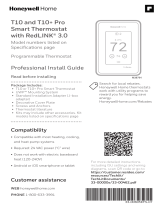
Patentes en trámite
® Marca comercial registrada en los EE.UU. © 2016 Honeywell International Inc.
69-2563EFS—03 M.S. Rev. 10-16
Impreso en EE. UU.
Automatización y control desenlace
Honeywell International Inc.
1985 Douglas Drive North
Golden Valley, MN 55422
http://customer.honeywell.com
Información regulatoria
Declaración de conformidad con las regulaciones FCC (Sección 15.19) (sólo en los EE. UU.)
Este dispositivo cumple con la Sección 15 de las regulaciones FCC. El funcionamiento está sujeto a
las dos condiciones siguientes:
1 Este dispositivo no debe causar interferencia perjudicial, y
2 Este dispositivo deberá aceptar cualquier interferencia que se reciba, incluso la interferencia
que pudiese causar el funcionamiento no deseado.
Advertencia de la FCC (Sección 15.21) (sólo en los EE. UU.)
Los cambios o las modificaciones que no hayan sido expresamente aprobados por la parte
responsable del cumplimiento de las regulaciones podrían anular la autoridad del usuario para
hacer funcionar el equipo.
Declaración de la FCC sobre interferencias (Sección 15.105 (b)) (sólo en los EE. UU.)
Este equipo fue probado y cumple con los límites de los dispositivos digitales clase B, conforme a
la Sección 15 de las regulaciones FCC. Estos límites están diseñados para ofrecer una protección
razonable contra la interferencia perjudicial en una instalación residencial. Este equipo genera, usa
y puede irradiar energía de frecuencia de radio y, si no se instala y se utiliza según las instrucciones,
puede producir una interferencia perjudicial en la comunicación radial. Sin embargo, no se garantiza
que no habrá interferencia en una instalación particular. Si este equipo produce una interferencia
perjudicial en la recepción televisiva o radial, lo cual puede determinarse al apagar y encender
el equipo, se recomienda que el usuario intente corregir la interferencia con una o más de las
siguientes medidas:
• Vuelva a orientar o ubicar la antena receptora.
• Aumente la distancia entre el equipo y el receptor.
• Conecte el equipo a un tomacorriente en un circuito diferente a aquel en el que está
conectado el receptor.
• Consulte con su distribuidor o con un técnico experto en radio/televisión para recibir ayuda.
Módulo de interfaz del equipo, termostatos y sensor para interiores
Para cumplir con los límites de exposición RF que establece la FCC y el Industry Canada para la
población en general/exposición no controlada, la o las antenas usadas para estos transmisores
deben instalarse a una distancia de, al menos, 20 cm de todas las personas, y no deben ubicarse ni
utilizarse junto con otra antena o transmisor.
Controlador central portátil
Este transmisor portátil y su antena cumplen con los límites de exposición RF que establece la
FCC y el Industry Canada para la población en general/exposición no controlada. Este dispositivo
no deberá colocarse ni accionarse conjuntamente con otra antena o transmisor.
Sección 7.1.2 de RSS-GEN
De acuerdo con las regulaciones del Industry Canada, este transmisor de radio puede funcionar
únicamente utilizando un tipo de antena y una ganancia máxima (o inferior) aprobada para el
transmisor por el Industry Canada. Para disminuir la interferencia potencial de radio con otros
usuarios, el tipo de antena y su ganancia deben elegirse de tal forma que la potencia isótropa
radiada equivalente (equivalent isotropically radiated power, e.i.r.p.) no sea mayor de lo necesario
para una comunicación eficaz.
Sección 7.1.3 de RSS-GEN
El funcionamiento está sujeto a las dos condiciones siguientes:
1 Este dispositivo no debe causar interferencia, y
2 Este dispositivo deberá aceptar cualquier interferencia, incluso la interferencia que pudiese
causar el funcionamiento no deseado del dispositivo.

















